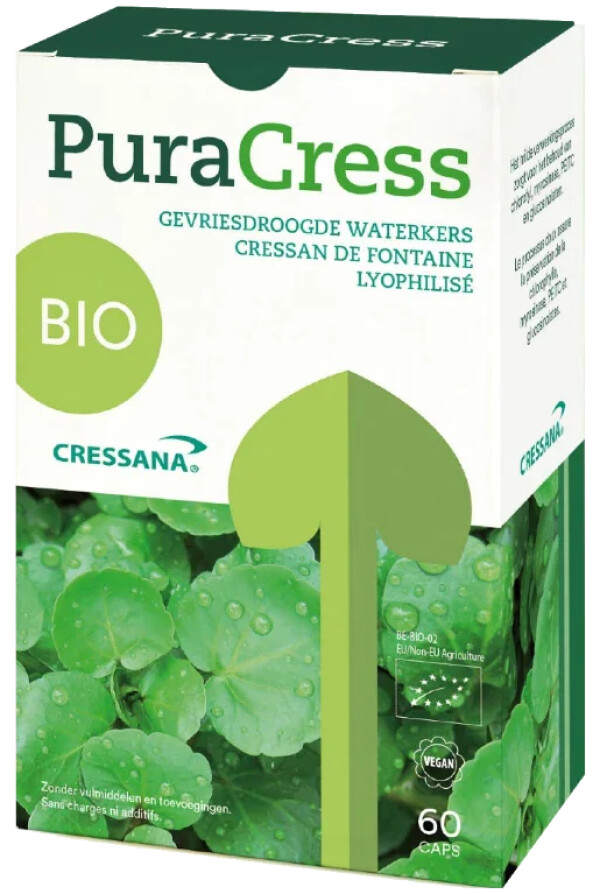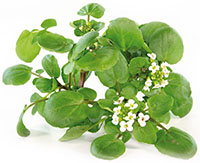8 Best Watercress Supplements

- Contains 300 mg of watercress per capsule
- 100% pure and certified organic

- Contains per capsule 150 mcg of iodine from kelp
- With chlorella and watercress

- From sea lettuce extract
- With watercress

- Contains 450 mg ashwagandha per capsule
- Contains 50 mg watercress per capsule

- Bevat 300 mg HCA in stabiele vorm per capsule
- With watercress

- Contains 375 mg of wild blueberry per capsule
- 100% pure and certified organic

- Source of antioxidants from watercress, wild bilberry, oregano and rosemary
- Standardized to 26.1 mg carvacrol per daily dose

- fermented black garlic
- Supplemented with algae extract and watercress
Read more about Cressana's unique watercress supplements below or order one of the watercress variants right away: for example with ashwagandha, iodine or magnesium.

Watercress
Watercress is a dark green leafy vegetable and grows as an aquatic plant in streams with cool, flowing water. Watercress belongs to the cabbage family, also called cruciferous after the shape of the flowers. All cabbages, broccoli, radishes, arugula, Brussels sprouts and sharp-tasting crops such as mustard and horseradish belong to it. The plants with the most beneficial effects are watercress and broccoli, these are also the most researched.
Watercress is a real vitamin and mineral bomb and is number one on the list of the most nutrient dense fruits and vegetables. Watercress contains more vitamins and minerals (vit A, B1, B6, C, K, E, iron, potassium, calcium, magnesium, manganese, zinc) than, for example, apples, broccoli and tomatoes.
Early healing power rediscovered
Round 1000 BC, watercress was already being praised by the Greeks against scurvy, intestinal worms, mental weakness and despondency. The physician Hippocrates had a clinic built 400 BC on Kos near large springs of water in which watercress was intensively cultivated. In the last 20 years, the herb has attracted more and more attention from important scientific institutions. Especially its regulatory effects on detoxification are part of their research.
 Watercress thus contains many nutrients. It is high in vitamin K and vitamin A, as well as rich in folate, vitamins C and B6, calcium, potassium, zinc and iron. Most of its calories come from protein.
Watercress thus contains many nutrients. It is high in vitamin K and vitamin A, as well as rich in folate, vitamins C and B6, calcium, potassium, zinc and iron. Most of its calories come from protein.
Also, Watercress contains:
- the carotenoids Lutein and Zeaxanthin. These are important antioxidants that protect the eyes.
- the phytonutrient Chlorophyll; the green dye in the leaves of plants that they use to capture sunlight and convert it into energy.
- indole-3-carbinol (I3C). In the intestines, this is converted to Di-indolylmethane (DIM complex).
- rich in many flavonoids, including the popular Quercetin.
- the omega-3 fatty acid Alpha-linolenic acid
Unique ingredients: the glycosinolates and isothiocyanates
In addition to a high content of vitamins and minerals, watercress also contains important sulfur-containing compounds: the glucosinolates. These compounds are converted during chewing (by the enzyme myrosinase and later in the digestive process by the intestinal flora) into a group of sharpening compounds. These are the actively protective substances Isothiocyanates. The glucosinolates in watercress are Allyl isothiocyanate and PEITC (2-Phenylethyl isothiocyanate).
Quality
The quality of watercress and the amount of pungent content depends on many factors. The growing conditions of watercress determine to a strong degree the content of bioactive compounds.
It proves very difficult to grow high-quality watercress in a so-called hydroponic culture: an artificial environment supplied with chemical fertilizers. Watercress grows best in its natural environment; fresh spring water from cool springs. Clean spring water provides the necessary minerals and trace elements. Only organically grown watercress can guarantee a truly pure product.
Cressana, a watercress company in Zwalm (Belgium) has developed a unique freeze-drying process. By freeze-drying one gets a drying process at low temperature that only removes water. This way freeze-dried watercress powder preserves the activity of the fresh plant and is guaranteed free of possible parasites.
